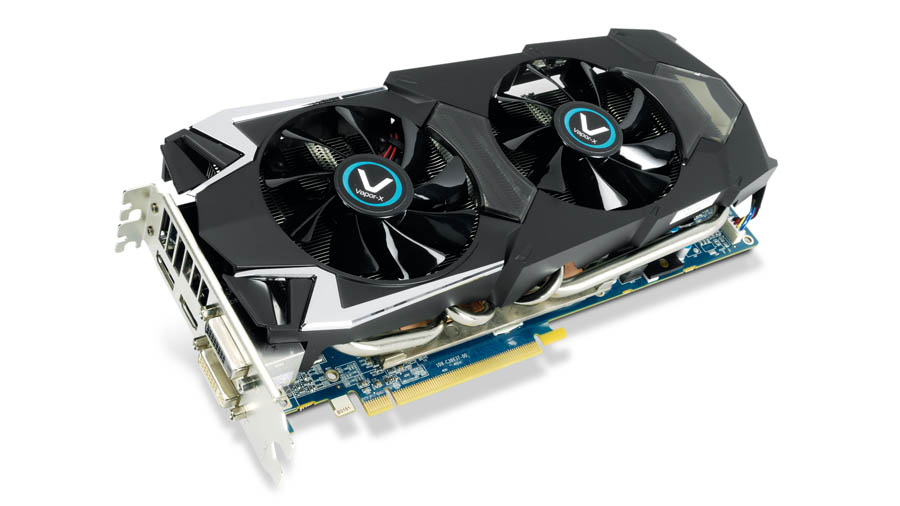TechRadar Verdict
Pros
- +
Good cooler
- +
Auto-OC works well
- +
Some more headroom for manual OC
Cons
- -
Expensive
- -
Trixxs software could be more user friendly
Why you can trust TechRadar
Did you buy shares in Apple in the 90s, which you've been holding onto? Did you manage to patent the spork, or invent a social media node that allows people to present their aspirational lifestyles in 140 characters or less?
We presume you've ticked off at least one of those, because this is the sharp end of the consumer GPU market, where prices are steep enough to make grown men weep.
Sapphire's version of the HD 7970 aims to push AMD's Graphics Core Next hardware to its very limits by boosting the core and memory clocks, and managing the excess heat with its top-of-the-line air cooling. It's not unreasonably pricier than the vanilla model, but does this Sapphire monster push the HD 7970 GHz Edition hard enough?
Like EVGA's Signature 2, its close competitor using Nvidia tech, the Vapor-X makes good on AMD's advancements in efficiency. The card powers itself up and down according to its workload, so boosting its clock values at full strain doesn't keep the fan whirring away or give you any heat-management nightmares.
Under load, the core clock boosts up by 200MHz, and when it's not in use, the factory values kick back in. When your machine's in standby the Vapor-X will power down to a negligible power usage and fan speed.
When considering efficiency, it looks like a dead, er, heat between EVGA and Sapphire's candidates for luxury GPU supremacy.
In gaming performance, Sapphire uses the GHz Edition's performance advantage over the GTX 680 to stretch its legs even further. We squeezed eight games through each card, each more unfeasibly demanding than a hungry toddler, and the Vapor-X was the clear winner.
It doesn't dominate across the board - there are moments at resolutions above 1080p in which EVGA's card prevails - but factoring in the effect drivers can have on each game, the Vapor-X's results offer about as much reassurance as possible that your - gulp - £400 is being well spent. It can even play Metro 2033 at max details at a vaguely playable 36fps at 1080p.
Realistically, the EVGA Signature 2's results were generally so close that you'd never notice a performance difference with the naked eye, but here in GPU fantasy land that isn't really the point. If you buy either card, you're likely to spend just as much time benchmarking and overclocking it as you do marvelling at its prowess.
Benchmarks
DirectX 11 gaming performance
Shogun 2: FPS: Higher is better
HD 7970 GHZ VAPOR-X: 86
GTX 680 SUPERCLOCKED: 85
DirectX 11 gaming performance
Batman: AC: FPS: Higher is better
HD 7970 GHZ VAPOR-X: 66
GTX 680 SUPERCLOCKED: 66
DirectX 11 gaming performance
DiRT Showdown: FPS: Higher is better
HD 7970 GHZ VAPOR-X: 40
GTX 680 SUPERCLOCKED: 25
Overclocking
If you have the cojones to push the card even further than Sapphire considers safe, its Vapor-X cooler will allow a modicum of further tampering. In fact the air coolers on both cards are exemplary in their low volume and high heat dispersal.
Sapphire's Trixxx software isn't as user-friendly as EVGA's Precision suite, but both allow tinkering with clock settings and boost ratios.
All told, this is a blinder of a card. It's not hugely relevant to most of us, but for just a little extra cash than AMD's fantastic reference GHz Edition, it pushes the HD 7970 architecture hard enough to impress enthusiasts. Fingers crossed for a price drop in the near future.

Ad creative by day, wandering mystic of 90s gaming folklore by moonlight, freelance contributor Phil started writing about games during the late Byzantine Empire era. Since then he’s picked up bylines for The Guardian, Rolling Stone, IGN, USA Today, Eurogamer, PC Gamer, VG247, Edge, Gazetta Dello Sport, Computerbild, Rock Paper Shotgun, Official PlayStation Magazine, Official Xbox Magaine, CVG, Games Master, TrustedReviews, Green Man Gaming, and a few others but he doesn’t want to bore you with too many. Won a GMA once.
